+++ Für die deutsche Version, bitte nach unten scrollen +++
On the 10th of December 2018, 39 scientists with 7 different nationalities safely embarked the German research vessel RV ‘SONNE’. The harbour of embarkment, Suva, Fiji, is for most scientists literally the other side of the world. There are many roads that lead to Fiji. It is therefore a small miracle that despite the high number of scientists and all the different travelling routes, only 1 package of luggage did not make it, yet.
While RV SONNE is lying in the harbour, being fuelled up in the broadest sense of the word, the scientists spread through the vessel, to unpack containers, learn the safety instructions and digest there first meal. Yes, even though we are not sailing yet, these are busy times.
The RV SONNE will leave port on the 11th of December 2018. She is headed for the Lau Basin in the Southwest Pacific. It will be a long stay at sea this time: 46 days, without getting to port. This means the ship is pushed to her limits, as the maximum amount of days the RV SONNE can safely stay at sea is 52 days.
During this time, a blog will appear regularly to inform the reader about the goings on aboard the RV SONNE, the progress of data acquisition and first results. We expect a good catch of data of course, but times at sea are unpredictable, so we’ll only know our final findings in 43 working days from now. The ARCHIMEDES-I cruise is very diverse in terms of data acquisition. There will be geophysical data acquisition (including seismic, bathymetric, magnetic and heat flow) but there will also be extensive mapping, sample recovery through dredging on the ocean floor, and there is even an AUV (Autonomous Underwater Vehicle) that will investigate the bottom of the ocean in great detail, all by itself.
The ultimate goal of the ARCHIMEDES-I cruise is to investigate the rifting and break-up of the Earth’s crust at the edge of a new continent that is emerging in the oceanic domain. In some locations valuable mineral deposits are formed in this setting, but not always. The Lau Basin presents a complex system but also an excellent model of the origin of crust, including different geological hazards as well as potential future resources. This is what the ARCHIMEDES-I cruise is all about: understanding the crustal processes in the oceanic domain to be able to predict future geological hazards and resources on the continents where we live.
The scientists of the ARCHIMEDES-I cruise on the RV SONNE have a mission. They are ready for take-off. The sun is shining bright on this side of the world and we truly hope the lost luggage will arrive on time. We wish the scientists and crew good luck and fair winds, may your mood stay positive and let Neptune be gentle on you.
Fare well!
ARCHIMEDES-I Ausfahrt: Startklar!
Am 10. Dezember 2018 betraten 39 Wissenschaftleraus 7 unterschiedlichen Nationalitäten das deutsche Forschungsschiff Sonne. Die FS Sonne liegt derzeit noch im Hafen von Suva, Fidschi, und damit an einem Ort, der für die meisten Wissenschaftler am anderen Ende der Welt liegt. Trotzdem, jetzt zu Beginn der ARCHIMEDES-I Ausfahrt führten alle unsere Wege, mit Ausnahme eines vermissten Gepäckstücks, direkt nach Suva.
Während die FS Sonne noch im ruhigen Hafen liegt und betankt wird, herrscht auf dem Forschungsschiff schon reges Treiben. Denn obwohl das wissenschaftliche Programm noch nicht begonnen hat, müssen viele Vorbereitungen getroffen werden: Container müssen entladen, Labore eingeräumt, Sicherheitsunterweisungen gehört und Mahlzeiten verdaut werden.
Am 11. Dezember 2018 verlässt die FS Sonne in der Abenddämmerung den Hafen und bricht auf in Richtung Lau Becken im Südwest-Pazifik. Ist das Lau Becken erreicht, wird die Sonne dort 43 Tage lang auf See bleiben. Mit einer so langen ununterbrochenen Zeit auf See (46 Tage insgesamt) ist die Sonne fast maximal ausgelastet, da sie für ein Maximum von 52 Seetagen konzipiert wurde.
Während der 43 Arbeitstage werden regelmäßig Blogs veröffentlicht, um Interessierte über Neuigkeiten, das Leben an Bord und erste wissenschaftliche Ergebnisse zu informieren.
Die ARCHIMEDES-I Ausfahrt zeichnet sich vor allem durch den stark multidisziplinären Ansatz der Forschung aus. Die wissenschaftlichen Methoden reichen von geophysikalischen Untersuchungen (z.B. Seismik, Bathymetrie, Magnetik, Wärmefluss) über AUV Tauchgänge (Autonomes Unterwasser Fahrzeug), bis hin zur geologischen Beprobung (Dredgen, Schwerelote).
Der Fokus der ARCHIMEDES-I Ausfahrt liegt dabei auf dem Auseinanderbrechen der Erdkruste am Rande eines neuen Kontinentes, der hier im Ozean entsteht. Hier können lokal auch polymetallische Massivsulfidlagerstätten auftreten. Das Lau Becken stellt zwar ein sehr komplexes System dar, kann aber auch als exzellentes Modell für die Entstehung neuer Kruste und der damit verbundenen geologischen Gefahren als auch potentieller zukünftiger Ressourcen gelten. Bei ARCHIMEDES-I dreht sich daher alles um die Erforschung der geologischen Prozesse in der Erdkruste zur Abschätzung zukünftiger Georisiken und Ressourcen auf den Kontinenten, auf denen wir leben.
Die Wissenschaftler der ARCHIMEDES-I Ausfahrt haben also eine klare Mission und sind startklar. Während die Sonne vom Himmel brennt, harren wir noch auf die rechtzeitige Ankunft des verlorenen Gepäckstückes. Wir hoffen auf den Erfolg unserer Mission, eine gute Stimmung an Bord und dass Neptun uns wohl gesonnen bleibt.
Auf Wiedersehen!
Blog: Anouk Beniest
Translation/Übersetzung: Anna Jegen
Fotos: Philipp Brandl/Nico Augustin
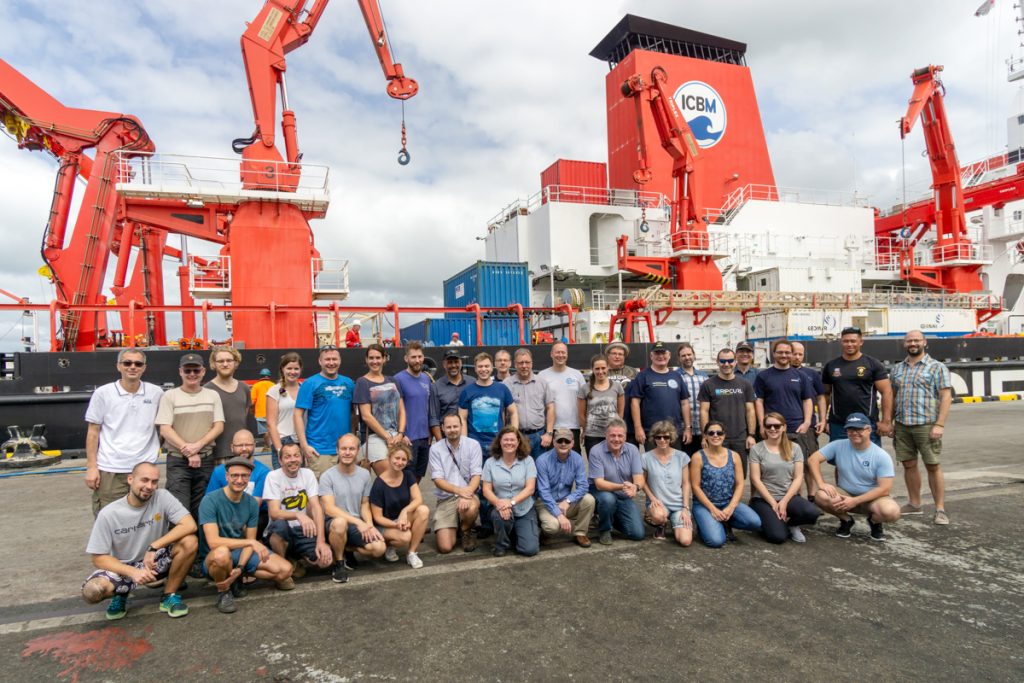
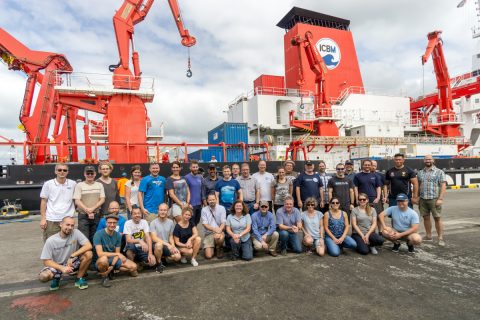
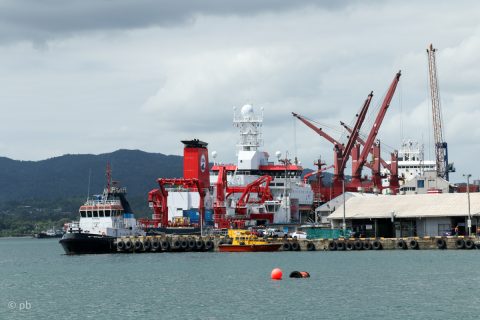

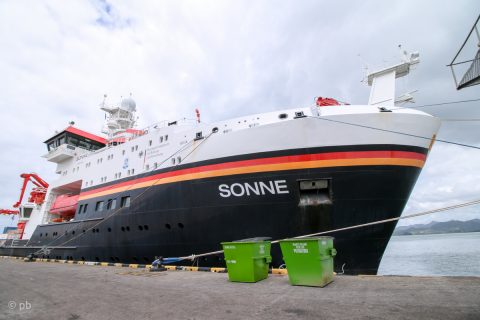
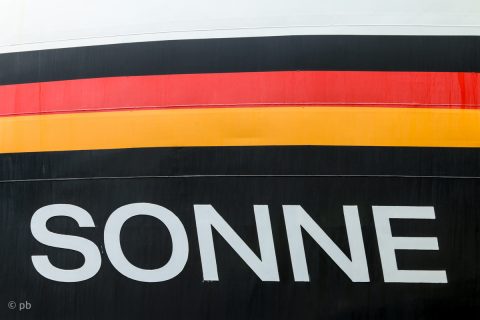
wir wünschen gute Fahrt und viel Erfolg